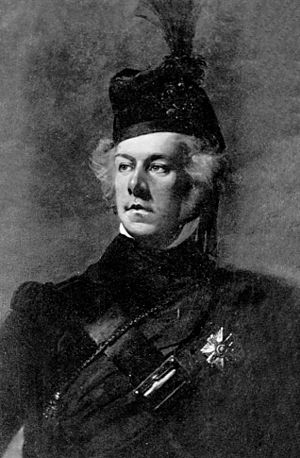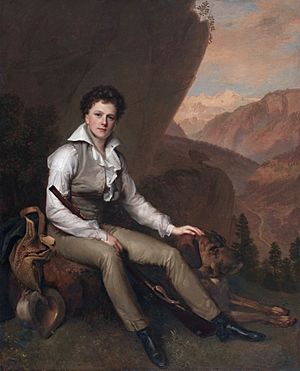John Campbell, 2nd Marquess of Breadalbane facts for kids
Quick facts for kids
The Most Honourable
The Marquess of Breadalbane
|
|
|---|---|

The Marquess of Breadalbane
by Sir George Hayter, 1834. |
|
| Lord Chamberlain of the Household | |
| In office 5 September 1848 – 21 February 1852 |
|
| Monarch | Victoria |
| Prime Minister | Lord John Russell |
| Preceded by | The Earl Spencer |
| Succeeded by | The Marquess of Exeter |
| In office 15 January 1853 – 21 February 1858 |
|
| Monarch | Victoria |
| Prime Minister | The Earl of Aberdeen The Viscount Palmerston |
| Preceded by | The Marquess of Exeter |
| Succeeded by | The Earl De La Warr |
| Personal details | |
| Born | 26 October 1796 Dundee, Angus, Scotland |
| Died | November 8, 1862 (aged 66) Lausanne, Switzerland |
| Political party | Liberal |
| Spouse |
Lady Elizabeth "Eliza" Baillie
(m. 1821; died 1861) |
John Campbell, 2nd Marquess of Breadalbane (born October 26, 1796 – died November 8, 1862) was an important Scottish nobleman and politician. He was a member of the Liberal Party. Before he became the Marquess of Breadalbane, he was known as Lord Glenorchy until 1831. From 1831 to 1834, he was called the Earl of Ormelie.
Contents
Early Life and Education
John Campbell was born in Dundee, Angus, Scotland. His father was Lieutenant-General John Campbell, 1st Marquess of Breadalbane. His mother was Mary, the daughter of David Gavin. John Campbell went to a famous school called Eton.
Political Career
John Campbell started his political journey as a Member of Parliament. He represented Okehampton from 1820 to 1826. Later, he represented Perthshire from 1832 to 1834.
In 1834, he became the second Marquess of Breadalbane after his father passed away. This meant he joined the House of Lords, which is part of the UK Parliament.
In 1848, he became a member of the Privy Council. This is a group of advisors to the British monarch. He was also appointed Lord Chamberlain of the Household by Lord John Russell. This important role meant he managed the royal household. He held this job until 1852. He served as Lord Chamberlain again from 1853 to 1858 under different Prime Ministers.
Other Important Roles
John Campbell was involved in many other public activities.
- He was a Freemason. He served as the Grand Master of the Grand Lodge of Scotland from 1824 to 1826.
- In 1834, he was chosen as a Fellow of the Royal Society. This is a group of top scientists.
- He became a Knight of the Thistle in 1838. This is a very high honor in Scotland.
- The next year, he was made Lord Lieutenant of Argyllshire. This role meant he was the Queen's representative in that area until his death.
- In 1842, he hosted Queen Victoria and Prince Albert at his home, Taymouth Castle.
- He supported the Free Church of Scotland during a big event called the Disruption of 1843.
He also held leadership positions at universities and other organizations:
- He was Rector of the University of Glasgow from 1840 to 1842.
- He was Rector of Marischal College, Aberdeen, from 1843 to 1845.
- He was President of the Society of Antiquaries from 1844 to 1862.
- He was Governor of the Bank of Scotland from 1861 to 1862.
In 1861, he went on a special trip to Berlin. He was there for the ceremony where King William I was given the Order of the Garter. He also received an award from Prussia, called the Knight of the Order of the Black Eagle.
Family Life
Lord Breadalbane married Lady Elizabeth ("Eliza") Baillie in 1821. She was the daughter of George Baillie. They did not have any children. Lady Elizabeth was a Lady of the Bedchamber to Queen Victoria, meaning she was a close attendant. She passed away in London in 1861 at age 58.
Lord Breadalbane died just over a year later, in Lausanne, Switzerland, on November 8, 1862. He was 66 years old. Because he had no children, some of his titles, like the Marquessate of Breadalbane, ended with him. A distant relative, also named John Campbell, inherited some other family titles. The Marquessate title was later brought back for the relative's son in 1885.
Lord Breadalbane's sister, Mary Campbell, married Richard Temple-Nugent-Brydges-Chandos-Grenville, 2nd Duke of Buckingham and Chandos in 1819.
Historical Compensation Payment
After the Slavery Abolition Act 1833 ended slavery in British colonies, the British government paid compensation to former slave owners. In 1837, a payment of £6,630 (worth a lot more today) was made to trustees connected to a marriage agreement involving Lord Breadalbane's family. This payment was for the Hope Plantation in Jamaica. Even though Lord Breadalbane's father had passed away, it is believed that the 2nd Marquess of Breadalbane received this payment as a trustee. The money eventually went to his nephew, the 2nd Duke of Buckingham and Chandos.




